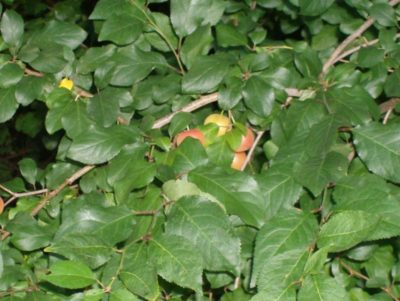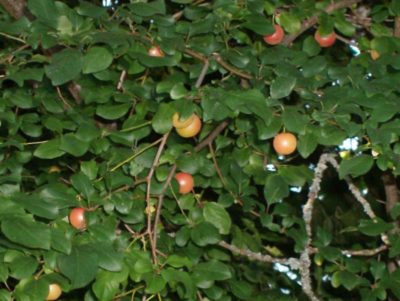
Cherry plum
Cherries and plums are closely related fruits. An in-between type of fruit is the cherry plum, which is actually a small plum belonging to the same genus (Prunus) as cherry and plum.
Cherry plums grow in temperate regions of Asia, Europe and North America and have edible fruits. The sweeter varieties can be eaten fresh, while the varieties with sour fruits can be used to make jams. The trees are also grown as ornamentals because of their early flowering immediately after the winter.
The taste of Cherry Plum is a mix of cherry and plum, which explains the name.
Names
Scientific
Prunus cerasifera
English
Cherry plum
Myrobalan plum
Dutch
Kerspruim
Kroos
Spanish
Ciruelo de jardín
Ciruelo mirobolano
Ciruelo-cerezo
French
Myrobolan
Prunier myrobalan
Prunier-cerise
German
Kirschpflaume
Myrobalane
Italian
Amolo
Mirabolano
Rusticano
Taxonomy
Order
Rosales
Family
Rosaceae
Genus
Prunus
Species
Prunus cerasifera (Cherry plum)
Basic information and facts
Origin:
Distribution:
Cherry plums are found in Europe, Asia and North America.
Evergreen or deciduous:
Deciduous
Flowers:
Flowers of the cherry plum appear very early in spring, often already in February. Flowers are white or pinkish-white with 5 petals and with a diameter of about 2 cm.
Leaves:
Cherry plum leaves are oval with a pointed tip and about 4 to 6 cm long.
Fruits:
Fruits of the cherry plum resemble cherries or like small plums. They are round, with a diameter of 2 to 3 cm and the color is red or yellow. Each fruit contains one big seed.
Climate and weather:
Cherry plums grow in temperate regions of Europe, Asia and North America.
Pollination:
Flowers of cherry plum are hermaphodite. They are pollinated by bees.
Height:
Cherry plums are shrubs or small trees with an open crown. They can be 6 to 15 meters tall.
Blooming period
Cherry plum flowers appear very early in spring.
Type of soil:
Cherry plums like fertile, moist but well drained soils.
Preferred pH:
?
Moisture:
?
Light:
Cherry plums can be grown in the sun or light shade. Sunny conditions are good for fruit production.
Growth rate:
Spacing
To produce fruits, cherry plums can be 3 meters to 4.5 meters apart. The cherry plum can be also grown for hedges of about 1.5 meter high when planting the trees about 60cm apart.
Propagation:
To maintain the quality of a good variety the cherry plum has to be propagated by vegetative methods such as layering or hardwood cuttings.
Insect pests:
Sometimes Aphids or Scales can attack the cherry plum.
Diseases:
Diseases of cherry plum include leaf spot and canker.
Fruit development:
Harvesting:
Ripe cherry plums are hand picked.
Uses:
Cherry plums can be eaten fresh. Varieties with a more sour taste are often used to prepare jams.
Proverbs and Quotes
Nothing about the cherry plum, but here are a few about cherries and plums.
- A black plum is as sweet as a white.
- A cherry year, a merry year; a plum year, a dumb year.
- If heaven above lets fall a plum, open your mouth.
- Receive a plum, return a peach.
- The higher the tree, the sweeter the plum
- There's no making apples of plums.
- You need plant only one cherry and one plum tree.
Crop categories
Cool temperate crops
Fruits
Mediterranean crops
Minor crops
Ornamental plants
Subtropical crops
Temperate crops
Pictures

Cherry plum

Cherry plum

Cherry plum

Cherry plum
